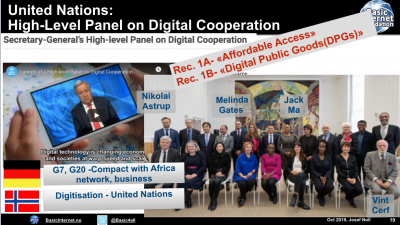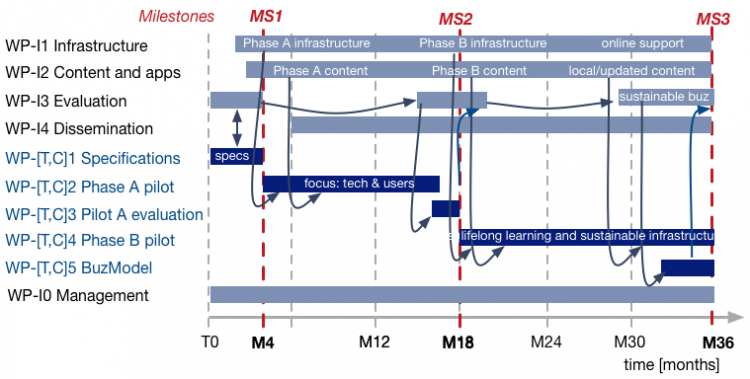DigI:Project
From its-wiki.no
| Digital Inclusion (DigI) | |||||||
|---|---|---|---|---|---|---|---|
|
Digital Inclusion - Project details
Read more about our main findings, lessons learned, recommendations. And if you want to know how to establish an Information Spot in your Community? Follow the how to link.
Main findings from the DigI project
Note: These findings are updated constantly, based on the finding of the DigI project
Through our activities in Africa we have clear indications for a successful Strategy for Digital Inclusion and Societal Empowerment.
In short:
- Health challenges as e.g. the Neglected Tropical Diseases (NTD) are strongly linked to neglected people. In addition, People with NTD can’t become productive members of the society, thus will have low added value to the society and suffer from low productivity
- Bad healthcare system pushes people into poverty. The lack of basic information, being part of the health ecosystem, has significant consequences both for decreased life expectance and increased mortality.
- Education & Health are linked, typically the younger generation, and female members of the society are the ones suffering most. Introducing digital health at school shows excellent results, as children influence their parents in a much better way than public campaigns do.
Thus our recommendation is to address health information by
- Building the ecosystem for societal and digital inclusion, with the freemium model for access and quality information being locally available.
- Our contribution to this general goal is the focus on information, and especially the implementation of the freemium model. Providing free access to information on education, health, agriculture, entrepreneurship and governmental information through local Information Spots, as well as premium access to broadband content, results in a profitable business model.
- The following components are essential parts of a holistic approach: Solar and other renewable energy, light, the mobile ecosystem for digital access, and free access for information for those not part of the digital society.
Through this holistic approach in building the ecosystem for societal and digital inclusion we empower people for digital health, education, mobile money/micro-credits,
Our goal is a new alliance for "Internet light for all" and Digital Rural development with Mobile operators, Telecom regulators, and Ministries, including "5G for Digital Inclusion".
We expect the path of inclusion:
- From Basic Infrastructure and Information to Health and Empowerment to Digital inclusion, Telecom business, and Socio-economic development
- The supporting business model follows the holistic approach, addressing the partnership with Telecom, Mobile Banks, Online-shopping, and other actors.
Having identified the villages for pilot roll-out, we currently address both Internet light for all infrastructure alternatives, health messages, key performance indicators (KPI), as well as the business model for the holistic partnership for Digital Inclusion.
Lessons learned
From the connection of the first villages, we achieved excellent results:
- In each village we find people being highly motivated to support the Internet Lite access
- Communities have taken up the concept, and deploy the information spots
- The cheap deployment using a 6 m pole to reach out even more than 20 km is available everywhere.
Standard poles come in the length of 6 m, which is sufficient for connectivity to reach the mobile network tower being more than 20 km away (case Selela market), or being hidden by the landscape (case Izazi). In addition, the 6 m poles reach up to 2-3 km point-to-multipoint connectivity in rural Tanzania.
In case of larger distances, our solution is to extend to 9 m high poles on the site of the sector antenna (case Migoli), allowing a line-of-site over the top of the trees. In case of the Izazi Dispensary, we used a 9 m pole at the governmental building, and added a 6 m pole at the dispensary.
DigI Achievements
After two years of operation, the following was achieved:
- we connected villages which were “impossible to connect” Izazi and Selela, where we extended the 3G network from typically 7-9 km to 22 km (Selela), or reached to a village behind a mountain ridge (Izazi).
- we established an infrastructure costing about € 1000 for the equipment and the configuration.
- we brought free information to schools Migoli: Nyerere High School, Market places Selela market, governmental buildings Izazi and will connect dispensaries Izazi Dispensary and Migoli village centre, in total we connect 10 villages/schools.
- we achieved tremendous positive feedback from the society. Does not matter where, we were welcome and got all the support we wanted. ‘’Everyone recognised the value of free access to information’’.
- We have already three communities (African Child, Bayama Orphanage and Community Services (BOACSE), Usevya Development Society (UDESO)) who picked up the ideas for connectivity, and established rural
- The mobile operators (Tigo and Vodacom) were very helpful in offering fair deals for the pilots, and involved us in their plans.
- National institutions like UCSAF with Justina Mashiba and Albert Richard fully supported us with background information to perform the roll-out.
- our input to the UN High Level Panel on Digital Cooperation is well reflected by the recommendations (especially 1A and 1B) and the mentioning of our work:
- Recommendation 1A: We recommend that by 2030, every adult should have affordable access to digital networks, as well as digitally-enabled financial and health services, as a means to make a substantial contribution to achieving the SDGs…
- Recommendation 1B: We recommend that a broad, multi-stakeholder alliance, involving the UN, create a platform for sharing digital public goods, ….
- Our claim on seeing recommendations 1A and 1B in conjunction, by providing "'free access to digital public goods, is reaching more and more attention.
- On the global scale, we started a discussion on "lightweight digital public goods" and the free access to this lightweight information with actors lite ITU and UNICEF.
- Capacity building is key of “Internet Lite for All”, with a village server with free access to information and apps to download
- Through the "Digital Inclusion" (DigI) project we reached tremendous interest, resulting in both academic presentation, but also invitations to ITU, the African Innovation Week, and other international events. See DigI Publications
And,
- early results from the medical intervention using video and animations to inform the local communities show outstanding results in health knowledge uptake.
Recommendations
Though, there are lot’s of areas still in need to be elaborated
- Adopting the Nordic model of 1 contract with up to 6 SIM cards and a combined data package to create a better base for the information spots,
- A framework for establishing and operating information spots in the villages. In a country being as big as Tanzania, the business model of operators does not allow a coverage of mobile broadband everywhere. Thus, combining mobile network with information spots is an excellent opportunity for digital inclusion, but is currently not addressed in the framework for mobile licenses.
- the distribution of vouchers and the costs for video. Currently, data packages cost 30.000-35.000 TZS for 10 GB data per month. Given that a video of 1 hour typically consumes 1 GB, that means that 1 video costs 3.500 TZS, which is beyond reach for the majority of people. Though, a solution might address sponsorship or social sharing of video content to the local village spot.
- Empower the communities to extend the access to information
- the development of the village platform enabling local communities to contribute to knowledge creation.
- The framework for governmental involvement, i.e. establishing the National Knowledge Portal in each country, by
- transferring the existing information into digital information and
- focus on new business models for free access to information, involving communities and mobile operators.
Structure of the work
The Project DigI is structured through 15 workpackages (WPs). The project is organised along 3 lines, being infrastructure (WP-Ix), and the pilots in Tanzania and DRC (WP-Tx, WP-Cx). The infrastructure related WPs address platform, access technology, content distribution, applications and services, and societal/business-related aspects. The specific pilots are structured along a timeline of specification, first phase pilots, evaluations and recommendations, second phase pilots, and finally the transfer towards sustainable business models for access to InfoInternet.
- WP-I4 Dissemination and Exploitation
- WP-T5 Sustainability of Operations
- Task TI3.2 Technology and Business Aspects
- WP-I0 Overall Management
- WP-I1 Information-Internet infrastructure
cost-effective infrastructure (satellite or radio-link), BYOD, Tablets- Task TI1.1 Low-cost infrastructure for InfoInternet
- Task TI1.2 Pilot installation Kjeller
- WP-I2 InfoInternet - Content and Apps
local content (Global Health Video), Health & EDU Content- Task TI2.1 Health Application development
- Task TI2.2 Creating interactivity for Health Videos
- WP-I3 Evaluation and Global Perspective
KPI knowledge base, literacy, "lessons learned"- Task TI3.1 KPIs for digital inclusion
- Task TI3.2 Technology and Business Aspects
- WP-I4 Dissemination and Exploitation
Extending the reach, addressing IT, Politics, Worldbank- Task TI4.1 Publications, Presentations
- Task TI4.2 Showcase material
Work in Tanzania
- WP-T1 Specifications for Tanzania
Priority of content, selection of villages- Task TT1.1 Awareness on One Health
- Task TT1.2 Sensitization on One Health through Apps and digital Content
- Task TT1.3 Selection of villages in TZ
- WP-T2 Pilot Phase A Tanzania
Extending the network, providing (limited) content- Task TT2.1 Infrastructure analysis
- Task TT2.2 Roll-out of Internet
- WP-T3 Phase A evaluations and Phase B Specifications
Lessons learned from phase A- Task TT3.1 Phase A evaluation
- Task TT3.2 Phase B specifications
- WP-T4 Pilot Phase B Tanzania
Extending the reach and the services- Task TT4.1 Phase B content
- Task TT4.2 Extending the reach in TZ
- WP-T5 Tanzania Phase B evaluation and suggestions for sustainable operations
Transformation into sustainable access- Task TT5.1 Phase B evaluation
- Task TT5.2 Sustainable business model for health information
Work in Mali/(Congo)
- WP-C1 Specifications for Congo (DRC)
satellite access extension, service selection- Task TC1.1 Specifications for the digital ecosystem
- Task TC1.2 Villages infrastructure in Panu and Kano
- WP-C2 Pilot Phase A DRC
Business opportunities in Panu and Kano s- Task TC2.1 Infrastructure analysis
- Task TC2.2 Roll-out of Internet
- WP-C3 Phase A evaluations and Phase B Specifications
Lessons learned from phase A- Task TC3.1 Phase A evaluation
- Task TC3.2 Phase B specifications
- WP-C4 Pilot Phase B Mali
Energy and Communication for entrepreneurship in local communities- Task TC4.1 Phase B content
- Task TC4.2 Extending the reach in SSA
- WP-C5 DRC Phase B evaluation and suggestions for sustainable operations
Transformation into sustainable access- Task TC5.1 Phase B evaluation, service update
- Task TC5.2 Sustainable business model for digital infrastructures
--->
Our Terminology
- Information spot - An information spot provides free access to local information, and to Internet Lite
- Free access to information is based on the Freemium model for access, with free access to information and premium access to broadband services on the Internet
- Internet Lite for All is the implementation of an Internet with text and pictures, enabled through light-weight protocols such as AMP
- Digital Inclusion and leaving no-one behind are the core drivers for the free access to information for all
- Societal Empowerment through digital inclusion, with focus on keeping the value within the community
- Digital Health for Digital Empowerment - Our research has proven that digital health information not only has significant results on health knowledge, but also empowers people digitally by learning on how to use digital devices and achieve information


